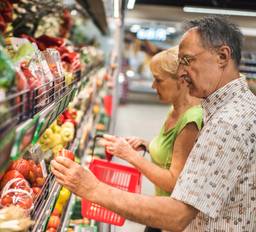How the supply chain impacts the cost of food
Sustainable Bites: Food and Our Future What can we do to help make our food systems more sustainable? UBC researchers share small steps that can make a big collective impact.
Grocery store food prices have skyrocketed. But what exactly drives the cost of food before it hits the shelves? And what can be done to get less expensive food on our tables, while making the systems involved more sustainable? Dr. Kelleen Wiseman, who teaches food and resource economics at UBC, and co-authored the 2024 Canada Food Price Report, looks at the supply chain.
Did you know?
- In 2022, Canada saw the highest rate of food inflation since the 1980s—a 40-year high.
- More than 3.1 billion people worldwide (42 per cent) were unable to afford a healthy diet in 2021.
What impacts the cost of food?
The price of food we see as consumers in the grocery store is not just what it costs to produce it, says Dr. Wiseman. It reflects “all the different elements that are in place in the supply chain to get that food to us in the form and at the time and place that we need it.”
Between farmers and consumers are food processors, food graders, packing houses, transporters, wholesalers, retailers and others—“all of whom have their own costs and requirements, like overhead and labour costs.”
Take bread. If the price of bread goes up by 10 per cent, it’s not necessarily because the price of wheat went up 10 per cent, or vice versa. It could be that the price of labour at some point in the supply chain went up and had a knock-on effect, Dr. Wiseman explains.
In addition, adverse climate events, rising geopolitical tensions, high oil prices, and a falling Canadian dollar have all been contributing to rising retail food prices along the supply chain.
How can policy help make food systems along the supply chain more resilient to climate change?
“There’s no question that we will see more volatility, because we will see more extreme weather conditions and supply chain snarls that will absolutely have an impact on our food prices,” says Dr. Wiseman.
Given that agriculture is also a large contributor to the climate change crisis, helping agri-businesses adapt to climate change should be a priority. Governments, Dr. Wiseman says, should be very strongly investing in innovation and research, like new energy sources, new drought-resistant crop varieties, and geographic information systems that monitor water and soil and flood control infrastructure.
That’s because these costs are too high for even large businesses to invest in on their own. But once this technology is available, food producers and companies will have the skills and motivation to implement more sustainable methods quickly, says Dr. Wiseman. “The returns on such government investments would be very high for everybody.”
How can consumers influence businesses to adopt more environmentally friendly agricultural practices?
Dr. Wiseman encourages consumers to hold companies accountable with their purchasing power.
Food production is a market-driven business, Dr. Wiseman says, and if we’re demanding environmentally friendly products as consumers, the supply will also shift.
She encourages consumers to research companies and figure out which are in line with their environmental and sustainability values. Read the sustainability reports and “make sure they’re not just greenwashing and are really doing what they say they are.” Then buy those particular products.
This article was published on March 8, 2024. Feel free to share the video and republish the text of this article, but please follow our guidelines for attribution and seek any necessary permissions before doing so. Please note that images are not included in this blanket licence.
More stories
- The wildfire season has started—here’s what we need to know in 2024
- Where the wild bees are—and aren’t—impacts food supply
- What is Indigenous data sovereignty and why does it matter?
- How technology can help reduce food waste
- Balancing sustainable agriculture with the need to feed the world
- Testing new ways to reduce the environmental impacts of food







